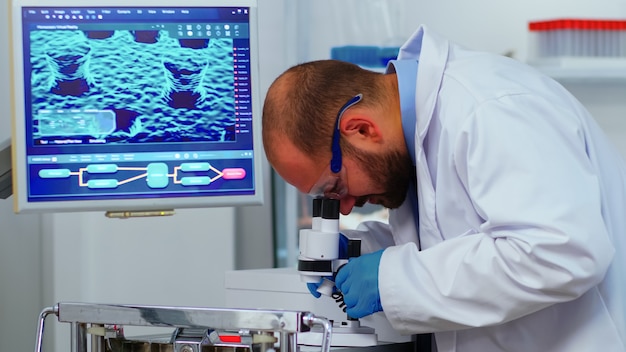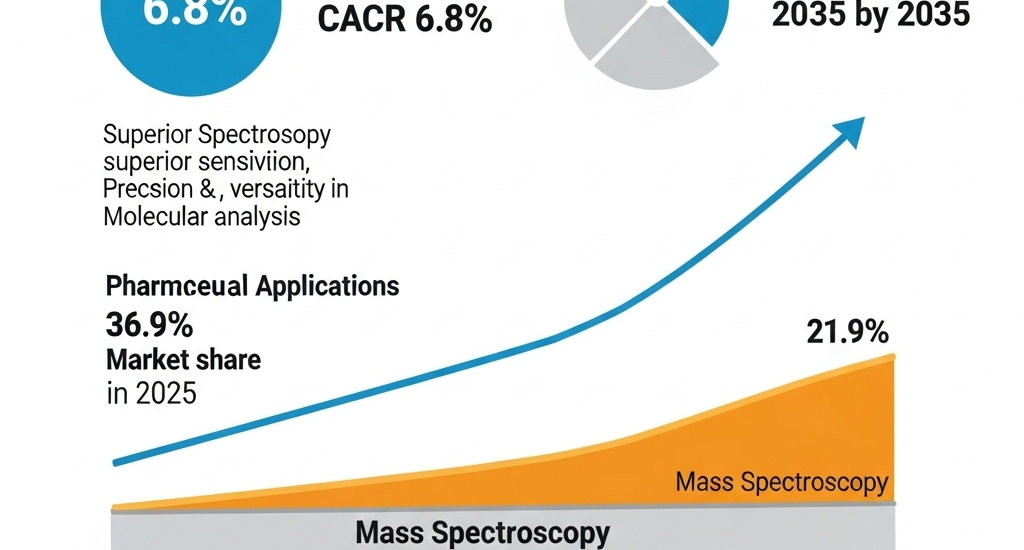The molecular spectroscopy market is reported to reach a valuation of at USD 7.3 billion in 2025 to USD 14.1 billion by 2035. Demand for molecular spectroscopy is expected to rise at a CAGR of 6.8% over the forecast period. Mass spectroscopy is expected to hold 36.9% share in 2025, attributed to high sensitivity, precision, and versatility in molecular analysis. Pharmaceutical Applications will dominate the Application segment with a 38.9% market share, owing to its critical role in drug discovery, development, and quality control.
Size & Trends
The molecular spectroscopy market is witnessing consistent growth, propelled by technological innovation and increasing investments in research and development. Global demand is driven by the expanding need for molecular-level analysis in healthcare and manufacturing.
- Emerging economies are showing a surge in adoption due to increased industrialization.
- Portable and handheld devices are gaining popularity for on-site applications.
- Automation in molecular spectroscopy is becoming a key trend across laboratories.
- Demand for faster and non-destructive testing methods is rising.
Pharmaceutical companies and food processing units are the major consumers, reflecting the market’s robust alignment with critical health and safety standards.
Get Sample Report: – https://www.futuremarketinsights.com/reports/sample/rep-gb-399

Challenges and Opportunities
While the molecular spectroscopy market continues to grow, it also faces specific hurdles. These challenges are accompanied by significant opportunities that companies can leverage for future expansion.
Challenges:
- High initial investment and maintenance costs hinder adoption among smaller organizations.
- A shortage of skilled professionals limits efficient instrument operation and analysis.
- Technological complexity can act as a barrier for new entrants in developing nations.
- Data management and integration with digital systems remain difficult for many users.
Opportunities:
- Increasing government funding for academic and industrial research creates new avenues.
- Expansion into environmental testing and food authentication presents untapped potential.
- Customization and miniaturization of devices enable access to small and mid-sized enterprises.
- Advancements in AI and machine learning can revolutionize data interpretation in spectroscopy.
As innovation continues, many of these challenges are expected to diminish, opening up broader markets and applications for spectroscopy tools.
Market Share by Geographical Region
The molecular spectroscopy market is distributed globally, with key regions showing varied levels of maturity and growth potential.
- North America holds a significant market share due to strong research infrastructure and high R&D expenditure.
- Europe follows closely, driven by stringent quality standards in pharmaceuticals and environmental monitoring.
- Asia-Pacific is emerging as a high-growth region, particularly in countries like China, India, and Japan.
- Latin America and the Middle East & Africa are witnessing gradual growth with increasing healthcare and industrial development.
Each region brings unique demand drivers, such as government initiatives in North America or expanding manufacturing capabilities in Asia-Pacific, shaping the global dynamics of the molecular spectroscopy market.
Top Companies
The molecular spectroscopy market is highly competitive, with several global players investing in innovation, mergers, and partnerships to strengthen their market presence.
- Thermo Fisher Scientific: A leader in providing comprehensive analytical instrumentation with strong global outreach.
- Agilent Technologies: Known for innovation in spectroscopy hardware and data software integration.
- Bruker Corporation: Offers a wide portfolio including NMR and infrared spectroscopy systems.
- PerkinElmer Inc.: Focuses on environmental and food safety applications, with an extensive customer base.
- Shimadzu Corporation: Offers cost-effective and efficient molecular spectroscopy solutions.
- JEOL Ltd.: Specializes in high-end spectroscopy systems for academic and research use.
These companies focus on continuous innovation, customer training, and post-sales support to maintain leadership in the evolving molecular spectroscopy market.
Explore In-Depth Analysis-Click Here to Access the Report:- https://www.futuremarketinsights.com/reports/molecular-spectroscopy-market
Segmentation Outlook
The molecular spectroscopy market is segmented based on technology, application, and end-user. Each segment plays a crucial role in determining the overall market direction and investment focus.
By Technology:
- Nuclear Magnetic Resonance (NMR) Spectroscopy
- Infrared (IR) Spectroscopy
- Ultraviolet-Visible (UV-Vis) Spectroscopy
- Raman Spectroscopy
- Near-Infrared (NIR) Spectroscopy
By Application:
- Pharmaceutical Analysis
- Food and Beverage Testing
- Environmental Testing
- Biotechnology and Life Sciences
- Academic Research
By End-User:
- Pharmaceutical Companies
- Academic and Research Institutes
- Environmental Testing Labs
- Chemical and Petrochemical Industries
- Food and Beverage Companies






